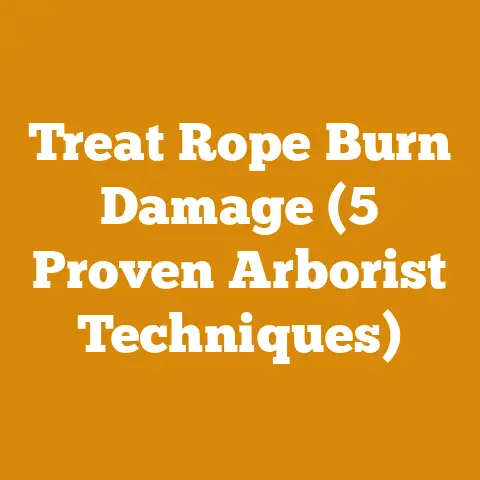Killing Trees with Copper Nails (3 Proven Wood Processing Hacks)
While the idea of a quick fix might be appealing, I’m here to tell you that there are far better, more effective, and environmentally responsible ways to manage unwanted trees.
I’ll explain why copper nails are largely a myth, and then I’ll delve into proven wood processing hacks that are actually useful and sustainable.
Debunking the Copper Nail Myth
The internet is rife with claims that hammering copper nails into a tree’s trunk will kill it.
The theory goes that the copper will poison the tree.
Let’s be clear: this is largely ineffective and often based on misunderstanding.
I’ve seen countless attempts fail in my years of working with wood.
Why Copper Nails Don’t Work
The primary reason copper nails don’t work as a reliable tree-killing method boils down to a few key factors:
- Dilution: Trees are incredibly resilient.
The amount of copper introduced by a few nails is usually too small to have a significant impact on a large tree’s system.
The tree’s natural defenses and vast vascular system dilute the copper, preventing it from reaching lethal concentrations. - Limited Distribution: Copper doesn’t easily move throughout the tree.
Its mobility is restricted, so the poison doesn’t spread effectively.
This means that even if you manage to introduce some copper, it’s unlikely to reach the roots or upper branches in sufficient quantities to kill the tree. - Tree Species Variation: Some tree species are more tolerant of copper than others.
What might theoretically work (though unlikely) on a sensitive sapling will have no effect on a mature oak or maple. - Environmental Concerns: Introducing heavy metals into the soil, even in small amounts, is generally not a good idea.
Copper can accumulate in the soil, potentially affecting other plants and organisms.
My Personal Experience
I remember a client who was convinced that copper nails were the answer to getting rid of a stubborn tree in their yard.
They hammered dozens of nails into the trunk, only to be disappointed months later when the tree continued to thrive.
This experience, along with countless others I’ve witnessed, solidified my understanding that copper nails are not a reliable solution.
The Science Behind the Failure
Scientifically, the idea that copper nails can kill a tree is flawed.
Trees have complex systems for dealing with toxins.
They can compartmentalize damaged areas, effectively isolating the copper and preventing it from spreading.
Furthermore, the amount of copper in a typical nail is simply insufficient to overwhelm a healthy tree’s natural defenses.
Takeaway: Forget the copper nails.
They’re ineffective, potentially harmful to the environment, and ultimately a waste of time and effort.
Proven Wood Processing Hacks for Tree Removal
Now that we’ve debunked the copper nail myth, let’s focus on proven and effective methods for dealing with unwanted trees.
These hacks involve proper tree removal techniques followed by efficient wood processing for various uses.
Hack 1: The Herbicide Method (Use with Caution)
When I talk about herbicides, I’m not advocating for reckless use.
Responsible herbicide application is a targeted approach to tree removal, especially useful for invasive species or trees that are difficult to remove by other means.
Understanding Herbicides
Herbicides are chemicals designed to kill plants. There are two main types:
- Foliar Herbicides: These are sprayed on the leaves and absorbed by the plant.
- Systemic Herbicides: These are absorbed and transported throughout the plant, killing it from the roots up.
The Hack: Cut Stump Treatment
One of the most effective herbicide application methods is the cut stump treatment.
Here’s how it works:
- Felling the Tree: First, you need to safely fell the tree.
This is crucial – if you’re not experienced with chainsaw operation and tree felling, hire a professional arborist.
Safety is paramount. - Immediate Application: Within minutes of cutting the tree down, apply a concentrated systemic herbicide to the freshly cut stump.
The herbicide will be absorbed into the stump’s vascular system and travel down to the roots, preventing regrowth. - Herbicide Selection: Choose a herbicide specifically labeled for tree and stump control.
Glyphosate and triclopyr are common active ingredients.
Read the label carefully and follow the instructions precisely. - Application Technique: Use a paintbrush or a small sprayer to apply the herbicide directly to the outer ring of the stump, just inside the bark.
This is where the cambium layer (the tree’s growth layer) is located. - Safety Precautions: Wear appropriate personal protective equipment (PPE), including gloves, eye protection, and a respirator if recommended by the herbicide label.
Case Study: Controlling Invasive Tree Species
I worked on a project where we had to remove a large stand of invasive tree-of-heaven (Ailanthus altissima).
These trees are notorious for their aggressive growth and ability to resprout from their roots.
We used the cut stump treatment with triclopyr to effectively kill the trees and prevent regrowth.
We monitored the site for several months afterward and retreated any new sprouts that emerged.
Considerations and Cautions
- Timing: The best time to apply herbicides is during the growing season when the tree is actively transporting nutrients.
- Environmental Impact: Be mindful of the potential impact on surrounding vegetation and wildlife.
Avoid applying herbicides on windy days or near waterways. - Regulations: Check local regulations regarding herbicide use.
Some areas may require permits or have restrictions on certain chemicals.
Takeaway: The cut stump herbicide treatment is a powerful tool for tree removal, but it must be used responsibly and with careful consideration for safety and environmental impact.
Always follow the herbicide label instructions.
Hack 2: The Frill Girdling Method
Frill girdling, also known as hack-and-squirt, is another effective method for killing trees using herbicides.
It’s particularly useful for larger trees where a complete felling might be difficult or dangerous.
How Frill Girdling Works
The process involves creating a series of overlapping cuts around the circumference of the tree trunk and then applying herbicide directly into the cuts.
- Making the Cuts: Using a hatchet or small axe, make downward-angled cuts into the bark and cambium layer around the entire tree trunk.
The cuts should be spaced close together, overlapping slightly to ensure a continuous ring. - Herbicide Application: Immediately after making the cuts, apply a systemic herbicide into each cut.
Use a squirt bottle or a small sprayer to ensure the herbicide reaches the cambium layer. - Herbicide Selection: As with the cut stump treatment, choose a herbicide specifically labeled for tree and stump control.
Glyphosate and triclopyr are commonly used. - Safety Precautions: Wear appropriate PPE, including gloves and eye protection.
Advantages of Frill Girdling
- Targeted Application: Frill girdling allows for precise herbicide application, minimizing the risk of off-target damage to surrounding vegetation.
- Gradual Tree Death: The tree dies gradually over several weeks or months, reducing the risk of sudden tree fall.
- Effective on Large Trees: This method is effective on large trees that might be difficult or dangerous to fell.
My Experience with Frill Girdling
I once used frill girdling to remove a large, diseased oak tree that was threatening a nearby building.
The tree was too close to the building to safely fell it.
By using frill girdling, we were able to kill the tree gradually and then remove it in sections, minimizing the risk of damage to the building.
Considerations and Cautions
- Herbicide Concentration: Use a higher concentration of herbicide for frill girdling than for cut stump treatment.
- Cut Depth: Ensure the cuts penetrate through the bark and into the cambium layer.
- Timing: As with the cut stump treatment, the best time to apply herbicides is during the growing season.
Takeaway: Frill girdling is a valuable technique for removing large or difficult-to-fell trees, but it requires careful execution and responsible herbicide use.
Hack 3: Efficient Firewood Processing
Once you’ve removed a tree, you’ll likely want to process the wood for firewood.
Efficient firewood processing can save you time, energy, and money.
Step 1: Bucking the Logs
Bucking involves cutting the logs into manageable lengths for splitting.
The ideal length will depend on the size of your wood stove or fireplace.
- Measuring: Use a measuring tape to determine the desired length of your firewood.
A common length is 16 inches, but you may need longer or shorter pieces depending on your needs. - Cutting: Use a chainsaw to cut the logs to the desired length.
Always use proper safety equipment, including a helmet, eye protection, hearing protection, and chaps. - Safe Cutting Practices: Ensure the log is properly supported to prevent pinching the chainsaw bar.
Use wedges to keep the cut open and prevent the log from rolling.
Step 2: Splitting the Wood
Splitting the wood makes it easier to handle, speeds up the drying process, and makes it suitable for burning.
- Manual Splitting: For smaller quantities of wood, a splitting axe or maul can be used.
Place the wood on a solid chopping block and swing the axe with a controlled motion. - Mechanical Splitting: For larger quantities of wood, a log splitter can save a significant amount of time and effort.
Log splitters are available in both hydraulic and electric models. - Splitting Techniques: Aim for the natural cracks in the wood to make splitting easier.
If the wood is particularly knotty, try splitting it from the edges rather than the center.
Step 3: Stacking and Drying the Firewood
Proper stacking and drying are crucial for producing high-quality firewood.
- Location: Choose a sunny and well-ventilated location for your woodpile.
This will help the wood dry quickly. - Stacking Method: Stack the wood in rows, leaving gaps between the rows to allow for air circulation.
Elevate the bottom layer of wood off the ground to prevent moisture from wicking up from the soil. - Drying Time: Allow the wood to dry for at least six months, and preferably a year or more.
The ideal moisture content for firewood is below 20%. - Moisture Meter: Use a moisture meter to check the moisture content of the wood before burning it.
This will ensure that you’re burning dry, efficient firewood.
Optimizing Firewood Production: My Insights
I’ve found that investing in quality tools pays off in the long run.
A good chainsaw, a reliable log splitter, and a moisture meter are essential for efficient firewood production.
I also recommend using a wood processor if you’re processing large quantities of wood.
These machines can buck, split, and load firewood in a single operation, saving you a tremendous amount of time and effort.
Takeaway: Efficient firewood processing involves proper bucking, splitting, and drying techniques.
Investing in quality tools and following best practices can save you time, energy, and money.
Advanced Wood Processing Techniques
For those looking to take their wood processing skills to the next level, here are some advanced techniques to consider.
Timber Grading
Timber grading involves assessing the quality of lumber based on its appearance and structural properties.
This is an essential skill for anyone working with wood for construction or woodworking.
Grading Standards
Timber grading standards vary depending on the region and the intended use of the lumber.
In North America, the National Lumber Grades Authority (NLGA) and the American Lumber Standard Committee (ALSC) set the standards for softwood lumber.
Grading Factors
The following factors are considered when grading timber:
- Knots: The size, number, and location of knots.
- Grain: The direction and spacing of the wood grain.
- Checks and Splits: Cracks in the wood caused by drying.
- Wane: The presence of bark or missing wood on the edge of the lumber.
- Decay: The presence of rot or other forms of decay.
Grading Classes
Lumber is typically graded into several classes, ranging from high-quality grades like “Select” and “Clear” to lower-quality grades like “Common” and “Utility.” The higher the grade, the fewer defects and the greater the structural integrity of the lumber.
Sawmill Operations
Operating a sawmill is a complex and demanding task, but it can be a rewarding way to process logs into lumber.
Types of Sawmills
There are several types of sawmills, including:
- Portable Sawmills: These are small, mobile sawmills that can be transported to the logging site.
- Stationary Sawmills: These are larger, permanent sawmills that are typically used for high-volume lumber production.
- Band Sawmills: These use a thin, continuous blade to cut the logs.
- Circular Sawmills: These use a circular blade to cut the logs.
Sawmill Operations
Operating a sawmill involves several steps, including:
- Log Handling: Loading and positioning the logs on the sawmill carriage.
- Sawing: Cutting the logs into lumber using the sawmill blade.
- Edging: Removing the bark and squaring the edges of the lumber.
- Trimming: Cutting the lumber to the desired length.
- Grading: Assessing the quality of the lumber and assigning it a grade.
- Stacking: Stacking the lumber for drying.
Safety Considerations
Sawmill operations can be dangerous.
It’s crucial to follow all safety precautions, including wearing appropriate PPE, using machine guards, and following proper operating procedures.
Wood Drying Processes
Proper wood drying is essential for preventing warping, cracking, and decay.
Air Drying
Air drying is the most common method of drying lumber.
It involves stacking the lumber in a well-ventilated area and allowing it to dry naturally.
Kiln Drying
Kiln drying involves using a controlled environment to dry the lumber.
This method is faster and more efficient than air drying, and it allows for more precise control over the moisture content of the lumber.
Drying Techniques
The following techniques can be used to improve the drying process:
- Stickers: Use stickers (thin strips of wood) to separate the layers of lumber and allow for air circulation.
- Weighting: Place weights on top of the stack of lumber to prevent warping.
- Covering: Cover the stack of lumber to protect it from rain and sun.
Safety Procedures
Safety should always be a top priority when working with wood processing equipment.
Personal Protective Equipment (PPE)
Always wear appropriate PPE, including:
- Helmet: To protect your head from falling objects.
- Eye Protection: To protect your eyes from flying debris.
- Hearing Protection: To protect your ears from loud noise.
- Gloves: To protect your hands from cuts and abrasions.
- Chaps: To protect your legs from chainsaw injuries.
- Steel-Toed Boots: To protect your feet from falling objects.
Machine Guards
Ensure that all machine guards are in place and functioning properly.
Lockout/Tagout Procedures
Follow lockout/tagout procedures when performing maintenance or repairs on wood processing equipment.
Emergency Procedures
Know the location of emergency equipment, such as fire extinguishers and first aid kits.
Be familiar with emergency procedures and know how to contact emergency services.
Takeaway: Advanced wood processing techniques require specialized knowledge and skills.
Safety should always be a top priority when working with wood processing equipment.
Common Mistakes to Avoid
Even with the best techniques, mistakes can happen.
Here are some common pitfalls to avoid when processing wood:
- Neglecting Safety: This is the biggest mistake. Always prioritize safety and use appropriate PPE.
- Dull Chainsaw: A dull chainsaw is dangerous and inefficient.
Keep your chainsaw sharp and properly maintained. - Improper Stacking: Stacking firewood improperly can lead to slow drying and decay.
- Rushing the Drying Process: Rushing the drying process can result in warped or cracked wood.
- Ignoring Wood Species: Different wood species have different properties and require different processing techniques.
- Overlooking Moisture Content: Burning firewood with high moisture content is inefficient and can damage your wood stove or fireplace.
My Biggest Learning Curve: I once tried to dry a large batch of oak firewood too quickly.
I stacked it too tightly and didn’t allow for proper air circulation.
The result was a pile of moldy, unusable wood.
This experience taught me the importance of patience and proper drying techniques.
Global Perspectives on Wood Processing
Wood processing practices vary significantly around the world, depending on factors such as climate, available resources, and cultural traditions.
- Scandinavian Countries: Known for their sustainable forestry practices and efficient wood processing technologies.
- North America: Emphasizes high-volume lumber production and advanced sawmill operations.
- Developing Countries: Often rely on manual labor and traditional wood processing techniques.
Understanding these global perspectives can broaden your knowledge and inspire you to adopt more sustainable and efficient wood processing practices.
The Future of Wood Processing
The future of wood processing is likely to be shaped by several key trends, including:
- Automation: Increased use of automation in sawmill operations and firewood production.
- Sustainability: Greater emphasis on sustainable forestry practices and responsible wood processing.
- Technology: Development of new wood processing technologies that are more efficient and environmentally friendly.
- Bio-Based Materials: Increased use of wood and wood-based materials in construction and manufacturing.
Staying informed about these trends can help you adapt to the changing landscape of the wood processing industry.
Conclusion
Killing trees with copper nails is a myth.
Focus on proven methods like herbicide application (used responsibly) and efficient wood processing.
Remember safety, invest in quality tools, and always prioritize sustainability.
With the right knowledge and techniques, you can effectively manage unwanted trees and transform them into valuable resources.






